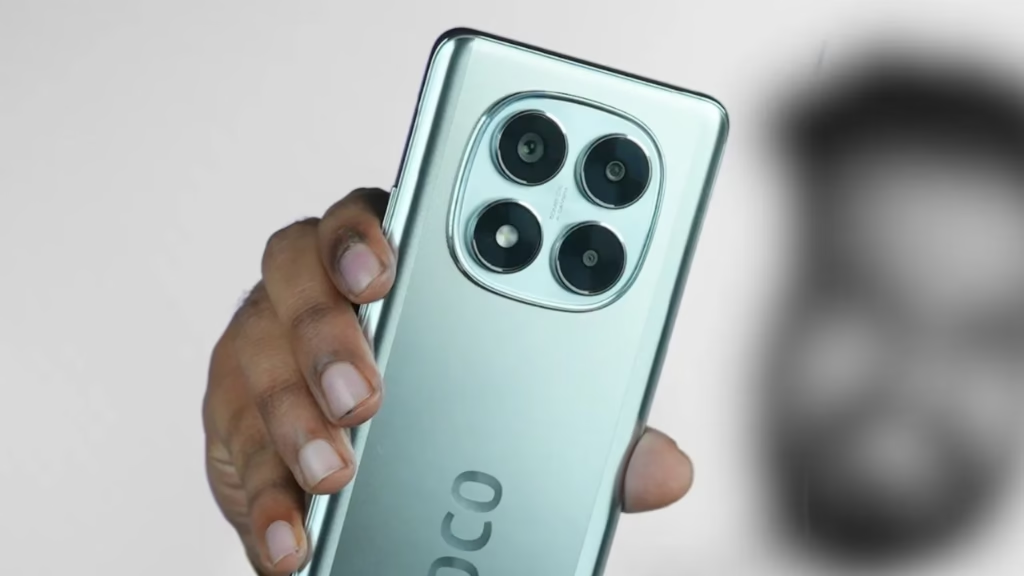There was a time when buying a budget phone felt like settling. You’d accept the plastic body, compromise on the camera, and convince yourself that lag was just “part of the experience.”
But every once in a while, a phone comes along that makes you go — “Wait, this costs how much?!”
That’s exactly what I felt the first time I picked up the Poco X7 5G.
This phone costs ₹21,999 and gives you a curved AMOLED display, an under-display fingerprint sensor, and even 4K video recording. I mean, what?
Naturally, I had to try it out. And not just for a day or two — I decided to push it, ditch the case, rip off the pre-applied screen protector, and use it as my main phone for two weeks. Call it curiosity, call it recklessness — but I wanted to see if this thing could really hold its own.
Spoiler: it did. And here’s my full, unfiltered experience.
Let’s Start With What You Get in the Box
Poco really deserves a pat on the back here.
While some brands (ahem Apple) are busy removing chargers, Poco is still doing it old school — in a good way.
Inside the bright yellow box, you’ll find:
-
A 45W charging brick
-
A Type-A to Type-C cable
-
A decent quality matte TPU case
-
SIM ejector tool
-
Pre-applied screen protector
-
And of course, the phone
No frills. Just the essentials — but they got everything right.
First Impressions: Premium Vibes Without the Premium Price


At 185–190 grams, it’s light enough to handle comfortably, and the curved screen melts beautifully into the frame. It’s smooth to hold, with no sharp edges or awkward bumps.
The camera bump isn’t obnoxious either, and somehow, it actually helps with the grip when you’re holding the phone sideways.
Is it one-handed friendly? If you have big hands — maybe. For the rest of us, it’s manageable with a bit of effort. But those curves really help with comfort.
Oh, and it survived light rain and wet hands like a champ. Poco claims it has IP69, but I wouldn’t go swimming with it. Think of it more like “accident-proof” rather than “adventure-proof.”
That Curved Display – It’s the Star of the Show


It’s a 6.67-inch 1.5K panel with:
-
120Hz refresh rate
-
Gorilla Glass Victus 2 protection
-
Dolby Vision
-
HDR support on YouTube
-
1920Hz PWM dimming (aka: it won’t hurt your eyes in low light)
Seriously, this screen is a joy. Watching YouTube, streaming Netflix, scrolling Insta — everything just looks vibrant, smooth, and immersive.
I compared it side-by-side with my iPhone 15 Plus, and the Poco X7 surprisingly had less flicker in dark conditions. That means it’s more eye-friendly for late-night doomscrolling.
The colors are customizable too — Saturated, Vivid, Natural — and even custom tones if you’re picky. Bonus: there’s Dark Mode to save on battery and look cooler.
And yes, the under-display fingerprint scanner works like a charm. It’s not lightning fast, but it’s reliable. Worked every single time for me.
Speakers, Calls and Mic – Surprisingly Solid
I’ll say it straight — the stereo speakers on this phone blew me away.
They’re loud. Like mini speaker loud. Watching reels without headphones? Totally doable. Calls on speakerphone? Crystal clear.
There are two microphones too, and they handle noise like a pro. Even in crowded areas, I didn’t have to repeat myself.
And the proximity sensor? No ghost touches. No weird screen wake-ups during calls. It just works.
Real-World Performance – Better Than Expected
Under the hood, the Poco X7 runs on the MediaTek Dimensity 7300 Ultra. I got the 8GB RAM + 256GB storage variant, running HyperOS (based on Android 14).
Day-to-day use? Smooth as butter.
Opening apps, switching between socials, streaming, texting — all seamless. The UI animations are fluid, and multitasking felt snappy.
Gaming, though, is where things get interesting.
I pushed it with:
-
Fortnite (yeah, I know): It ran at around 32-35 FPS. Not perfect, but didn’t lag either.
-
Call of Duty: Mobile: High settings, Ultra frame rate — no issues.
-
BGMI: HDR graphics + Ultra frame rate = buttery smooth.
You won’t be hitting flagship numbers here, but for a ₹22K phone? It holds up. Especially for casual gamers.
Also, you can edit 4K videos on VN smoothly — just don’t expect it to handle 120fps footage without stutter.
My AnTuTu score came in at over 637,000 — pretty solid for this segment.
Camera – Good for Socials, But Not for Pixel Peepers
Let’s be clear — this isn’t a camera phone. But it’s also not a disappointment.
You get:
-
50MP Sony main sensor (f/1.5 aperture)
-
8MP ultra-wide
-
2MP macro
-
20MP front camera
Daylight:
Photos look vibrant, a bit warm-toned, and slightly saturated — which is great for social media. The 50MP mode is tucked under “More,” but honestly, you’re fine with regular shots too.
Portraits are sharp. Edge detection works well even with tricky backgrounds like trees or people wearing glasses.
Low light:
That f/1.5 aperture helps a lot. You get usable results even without night mode. Turn on night mode and it takes a few seconds to process, but results are sharp and well-balanced.
Ultrawide:
Good in daylight. Average in low light. Not much else to say.
Video:
-
Rear: 4K at 30fps (stabilized, focus is quick, colors are natural)
-
Front: 1080p at 60fps (clear in daylight, struggles in low light)
-
Ultrawide video is capped at 1080p and isn’t the sharpest
The 2MP macro camera? Honestly, it’s just there for symmetry.
Selfies:
Sharp and natural during the day. Even in night conditions, the screen flash helps brighten things up. Group selfies with portrait mode also came out surprisingly well.
Battery – No Anxiety Here
With a 5110mAh battery and 45W fast charging, this phone is built to last.
I regularly ended the day with 20-30% left, even with heavy use (Wi-Fi + 5G, Netflix, YouTube, Insta, calls). On lighter days, I even got 1.5 days of use.
Charging from 0 to 100 takes around 55 minutes, which is great considering the size of the battery.
HyperOS also has good battery optimization tools — like auto-brightness tuning, app freezing, and thermal control.
Software: A Mix of Freedom and Frustration
HyperOS is better than MIUI, no doubt.
You get:
-
Full control over themes, fonts, icons
-
Custom lock screen styles
-
Smooth animations
But…
There’s still bloatware. Some you can delete, some you’re stuck with. Also, it occasionally sends unwanted notifications, which is annoying.
And it’s on Android 14, while newer phones are starting to ship with Android 15. You do get 3 years of major Android updates though — so Android 17 is guaranteed.
Final Verdict – Should You Buy the Poco X7 5G?
The Poco X7 isn’t trying to be a flagship. It’s not pretending to be the best at everything.
But here’s the thing — for ₹21,999, it does a lot really well:
-
Curved AMOLED display?
-
Good day-to-day performance?
-
Loud speakers, reliable network, and smooth UI?
-
Decent camera for socials?
-
Solid battery life?
It’s not perfect. The plastic back scratches. The macro camera is a gimmick. There’s bloatware. And it’s not made for hardcore gaming.
But if you want an affordable phone that feels premium, performs reliably, and looks stunning, the Poco X7 5G should absolutely be on your shortlist.


